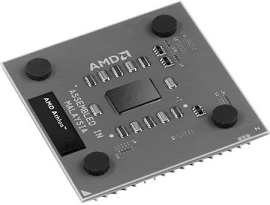AMD Athlon
The Athlon is AMD's successor to the K6 series. The Athlon is a whole new chip from the ground up and does not interface via the Socket 7 or Super7 sockets like its previous chips. In the initial Athlon versions, AMD used a cartridge design, called Slot A, almost exactly like that of the Intel Pentium II and III.
This was due to the fact that the original Athlons used 512KB of external L2 cache, which was mounted on the processor cartridge board. The external cache ran at one-half core, two-fifths core, or one-third core depending on which speed processor you had.
In June 2000, AMD introduced a revised version of the Athlon (codenamed Thunderbird) that incorporates 256KB of L2 cache directly on the processor die. This on-die cache runs at full-core speed and eliminates a bottleneck in the original Athlon systems.
Along with the change to on-die L2 cache, the Athlon was also introduced in a PGA or chip Socket A version, which replaced the Slot A cartridge version. The most recent Athlon version, called the Athlon XP, has several enhancements such as 3DNow!

Professional instructions, which also include the Intel SSE instructions. The latest Athlon XP models have also returned to the use of 512KB L2 cache, but this time at full processor speed.
Although the Slot A cartridge looks a lot like the Intel Slot 1, and the Socket A looks like Intel's Socket 370, the pinouts are completely different and the AMD chips do not work in the same motherboards as the Intel chips. This was by design because AMD was looking for ways to improve its chip architecture and distance itself from Intel.
Special blocked pins in either socket or slot design prevent accidentally installing the chip in the wrong orientation or wrong slot. Socket A versions of the Athlon closely resemble the Duron. The Athlon is available in speeds from 550MHz up to 1.4GHz and uses a 200MHz or 266MHz processor (front-side) bus called the EV6 to connect to the motherboard North Bridge chip as well as other processors.
Licensed from Digital Equipment, the EV6 bus is the same as that used for the Alpha 21264 processor, now owned by Compaq. The EV6 bus uses a clock speed of 100MHz or 133MHz but double-clocks the data, transferring data twice per cycle, for a cycling speed of 200MHz or 266MHz.
Because the bus is 8 bytes (64 bits) wide, this results in a throughput of 8 bytes times 200MHz/266MHz, which amounts to 1.6GBps or 2.1GBps. This bus is ideal for supporting PC1600 or PC2100 DDR memory, which also runs at those speeds.
The AMD bus design eliminates a potential bottleneck between the chipset and processor and enables more efficient transfers compared to other processors. The use of the EV6 bus is one of the primary reasons the Athlon and Duron chips perform so well.
The Athlon has a very large 128KB of L1 cache on the processor die and one-half, two-fifths, or one-third core speed 512KB L2 cache in the cartridge in the older versions; 256KB of full-core speed cache in Socket A Athlon and most Athlon XP models; and 512KB of full-core speed cache in the latest Athlon XP models.
All PGA socket A versions have the full-speed cache. The Athlon also has support for MMX and the Enhanced 3DNow! instructions, which are 45 new instructions designed to support graphics and sound processing. 3DNow! is very similar to Intel's SSE in design and intent, but the specific instructions are different and require software support.
The Athlon XP adds the Intel SSE instructions, which it calls 3DNow! Professional. Fortunately, most companies producing graphics software have decided to support the 3DNow! instructions along with the Intel SSE instructions, with only a few exceptions.
The initial production of the Athlon used 0.25-micron technology, with newer and faster versions being made on 0.18-micron and 0.13-micron processes. The latest versions are even built using copper metal technology, a first in the PC processor business.
Eventually all other processors will follow because copper connects allow for lower power consumption and faster operation. In most benchmarks the AMD Athlon compares as equal, if not superior, to the Intel Pentium III. AMD beat Intel to the 1GHz mark by introducing its 1GHz Athlon two days before Intel introduced the 1GHz Pentium III.